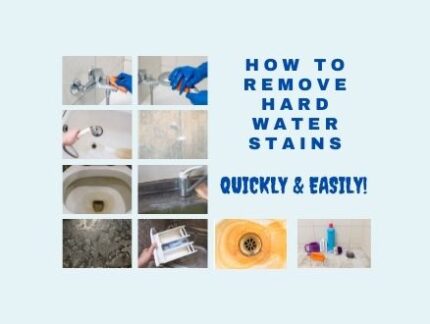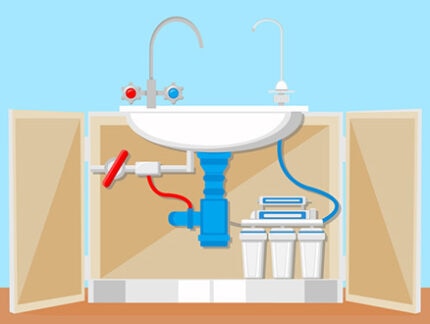Suppose you’re very particular about your water’s cleanliness. In that case, the chances are that you’ve already gone through several products, trying to find the best under sink water filter. If this will be your first buy, you’re still likely to have been lost in the avalanche of product reviews. Don’t worry. It’s not just you.
To help solve that problem, we went through several products and nearly twice as many hours of research to pick the best under sink water filters. One of our most important selection criteria was the sheer number of contaminants the filter removes.
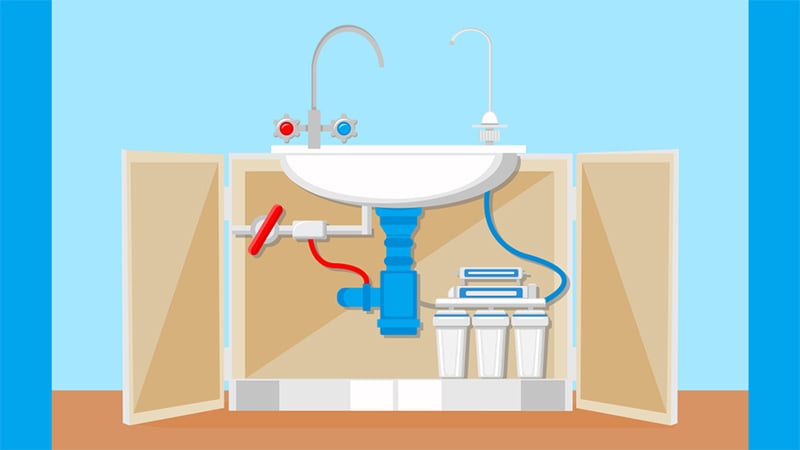
Only (5) five of the products we came across met the required criteria, with over a hundred contaminants eliminable. In our under sink water filter reviews, we’ll run you through an intricately detailed guide to under-counter water filter systems and recommend the ones that best fit your needs.
- Why You Should Get an Undersink Water filter?
- Types of Under-Sink Water Filters
- How Does an Under-Sink Water Filter Work?
- Buying Considerations
- How We Picked Under-Sink Water Filters?
- How We Tested Under Sink Water Filters?
- 5 (Five) Best Product Reviews
- How to Install an Under-Sink Water Filter?
- How to Clean and Replace Filter Cartridges?
- Under Sink Water Filters vs. Countertop Water Filters
- Under-Sink Water Filters vs. Water Pitcher Filters
- Tips and Cautions
- Conclusion
- FAQs
Before going there; you might be interested>>
Why You Should Get an Undersink Water Filtration System
In the last couple of years, water filters have only become more and more popular. This suggests that they have certain benefits that keep people coming back every couple of years/months. Here are a few of those benefits and why you should get an under sink water filter:
1. Increase the healthiness of the water
Suppose your water contains multiple contaminants that need to be eliminated. In that case, it goes without saying that your water is unsafe to drink. Depending on the level of contamination, you might not drop down to your knees and pass out immediately after you have a glass. But, prolonged consumption of impure water is sure to leave its mark on you. A water filtration system helps increase the healthiness of your drinking water by taking out contaminants.
2. Help improve look and taste
The whole point anyone grabs a glass of water is to enjoy a tasteless, odorless, and colorless drink that’ll effectively quench their thirst. Anything other than that, and you might as well grab a bottle of soda or something.
Unfortunately, the most cost-effective water source – tap water – is often ridden with contaminants that can change the water’s color and/or taste. Water filters help to take out these contaminants and help your water taste better.
3. Cost-effective
There are a few alternatives to getting an under sink water filter. One of them is buying bottles of prefiltered water. This might seem alright to you, but consider the cost of going to the grocery store every other day or having it delivered to you. Then, consider the cost of the bottled water themselves. If you have a whole family of four and above, it’s simply impractical.
Another alternative is a freezer filter or a faucet filter. Neither of these is quite as effective as an under-sink water filter. So, while there’s a chance that they might cost less, they certainly wouldn’t be giving a lot of value for money, and therein lies the problem.
Under sink water filters, however, come at very reasonable costs with excellent quality of service compared to their alternatives.
Besides all of these, you should consider getting a water filtration system because:
- Relatively easy to install.
- Come in different models and categories, providing a dash of variety.
- Particularly straightforward to maintain.
You should note that, unlike whole house water filtration systems, you can only access it at the point of use. But, if you put your water filter at a strategic point, like a kitchen you mostly drink from, this shouldn’t be a problem.
Types of Under-Sink Water Filters
There are currently three major types of under sink water filters. They are:
1. Simple under-sink water filter
In the simplest terms possible, a simple under sink water filter is one that connects to the water line that you already have, allowing clean water to flow out of your kitchen faucet.
These types of filters are incredibly versatile and can be used with a refrigerator water line or an ice maker. They save you the trouble of having to install separate faucets. They also come at very reasonable prices while helping to eliminate multiple harmful substances.
However, it is worthy of note that their versatility could also be a disadvantage sometimes. If you’re using them for multiple water lines, there’ll be a ton of dirt passing through them very often. This means you’ll have to replace the filters more regularly than the average water filter.
2. Conventional under-sink water filter
Much like a simple under-sink water filter, this type of water filtration system connects directly to your water line, and you have to install it underneath your sink. However, the primary difference between the two is that this one comes with a dedicated water filter faucet.
This means that you have a separate line/faucet where you can get filtered water. The benefit of this is that you’ll still retain your normal tap water faucet for dishes and other things that don’t need to have all the water contaminants entirely removed.
A conventional under-sink water filter takes away the need to change your filter constantly. This is because the dedicated filter faucet would only have water coming through it when you need it for drinking.
3. Reverse osmosis (RO) under-sink water filter
These are special water filters that complete the job in multiple stages and use a tank system to “flush” out any contaminants in your water. They work based on the principles of reverse osmosis, which has multiple applications in tech. The tank system absorbs contaminants and allows only clean water to pass. This is possible with a type of resin installed in the tank.
Many RO water filters have dedicated faucets, much like their conventional counterparts. As explained earlier, this will help you save money on filter replacements. Many people consider the reverse osmosis water filtration system the best in the market.
However, it does have a few minor drawbacks. The first is that its unique filtration system requires it to drain out “unclean” water. Some consider this a waste of water. Another small drawback is that it requires some level of expertise to install, unlike its counterparts that are generally simpler to work around.
How Does an Under-Sink Water Filter Work?
The process an under sink water filter follows to get water to you is pretty simple. First, the water goes into the filter from the cold water line through a special tube designed for that purpose. Then, it passes through another tube after filtration to get to your dedicated filter faucet.
Things to Consider Before Buying a Water Filter System for Your Sink
1. Know What Needs to Be Filtered From Your Water
The type of kitchen water filter that would work best for you is entirely dependent on the type of contaminants or particles you have in your water. If you’re primarily concerned with bad taste resulting from chlorine, you might not need more than a simple carbon filter. It would certainly be more cost-effective than getting an “overpowered filter.”
On the other hand, if you’re dealing with significantly more polluted sources of water where you have to contend with TDS like sodium, you might need more formidable under-counter water filter systems. A good example is virtually any under sink water purifier that utilizes a special reverse osmosis system of cleansing.
2. Size and Capacity
When picking a water purifier for your sink, you also need to consider the size of the sink filter alongside the space available under your kitchen sink.
A reverse osmosis system, for example, has an extra tank. This extra tank needs more space than simple and conventional water filters. As such, you’ll need to consider your kitchen cabinet space before you decide on it.
Other complex systems require upwards of five extra filters you’ll need to mount in your kitchen cabinet. Essentially, make sure that you have enough space for the system you’re going for.
Regarding capacity, you need to know how much water your system can provide you at a time. For simple and conventional filter systems mounted directly on your water line, capacity isn’t a problem. But for RO systems that come with a tank, you’ll need to pick something large enough to cater to your unique water consumption needs at a time. Otherwise, you’d have to wait several minutes between each cup of water.
3. Water Pressure/Flow Rate
Many homeowners believe that the installation of a filtration system automatically equals slow down their flow rate. They are right, especially when you consider that the water has to go through several filtration “stops,” depending on its level of contamination.
However, under-sink water filter system makers are constantly working to maximize flow rates. So, technically speaking, it’s still possible to get a kitchen water filter with a reasonable flow rate. For clarity, the flow rate is measured in gallons per minute (GPM). It often ranges from 0.8 – 2 GPM. Before buying your under-sink filter, you should always check the GPM to ensure that you don’t have to deal excessively with low water pressure.
4. Ease of Installation
Getting an under-the-sink water filter system would be entirely useless if you cannot install it in the first place. Thankfully, companies are continuously working to make installation more user-friendly. However, different systems still have different requirements and varying levels of expertise for installation.
RO systems, for instance, are generally more complex, with multiple parts and hoses for bringing water in and out of the tank. This doesn’t make them impossible to install. It requires a bit more attention to detail than the standard simple/conventional systems that don’t need much trouble.
5. Maintenance Factors
Like many other kitchen appliances, your sink filter will not remain perfect forever. At different points in time, it would require maintenance, which includes replacing the filter itself. This is an important factor you have to consider.
On average, you’ll need to change your filter once a year. If your water is particularly contaminated, it means that the system would need to work twice as hard. This would automatically lead to quicker wear and tear, meaning you might have to replace even sooner and the usual once a year.
Generally, you should be on the lookout for something that’s naturally tough and wouldn’t get worn out too easily. This is where the filter membrane capacity comes into play.
6. Filter Replacement Cost
A water filter under your sink is significantly less expensive than a whole house filtration system. However, as you might be able to imagine, it’s not a one-off thing. Every now and then, you’ll need to change your filter, especially if your water has a high contamination rate.
In that case, you need the most cost-effective option. Depending on the type of system you get, you might only need to spend between $30 to $180.
However, keep in mind that the cheapest isn’t always the best. You also need to remember other factors earlier mentioned. If you choose one simply because it saves you the most money, you might end up with a bad case of buyer’s remorse.
7. NSF/ANSI and WQA Certifications
These bodies/organizations form the industry standard for water filter certification. They conduct rigorous tests to determine the viability of water filtration products. If the products meet the required standards after testing, the bodies will certify them.
Otherwise, the inverse is the case. Any product with NSF/ANSI and WQA certifications to back its filtration claims is likely worth the buck. So, always keep an eye out for this.
Additional Considerations
Here are a few more things to remember when searching for the best under sink water filter.
Upfront Pricing
This isn’t a primary consideration because, as we said, cheaper doesn’t always equal better. Nevertheless, it’s important. Ensure that the upfront cost of the under sink water filter is something you can afford. And while it’s affordable, it should also offer value for your money.
Waste vs. Pure Water Ratio
If you’re passionate about the environment, this could also be an essential factor for you to consider, especially if you’re getting an RO system with a tank. Knowing the waste vs. pure water ratio will help you determine how much water is being wasted. That way, you can control your negative impacts on the environment. You should generally aim for. Waste: Pure Water Ratio of no more than 3:1.
Minerals Added
While removing contaminants, many water filters end up taking out the most important minerals in drinking water. To combat this, companies have begun adding healthy minerals to their products so that water is filtered better without losing its natural components. To ensure that you’re getting the best from your water, you should check if your preferred water filter maker adds any extras to its filtration process.
Warranty and Support
Before getting any tech or home appliance, you must check their warranty and customer support. You don’t want a situation where you have challenges using the gadget, and there’s no one to call for help.
Reputation and Customer Feedback
Brands and products are often only as good as people say they are. If many people are complaining about its poor quality, the chances are that it’s not very good and vice versa. So, do well to check the customer reviews and feedback on the product before making a purchase.
How We Picked and Tested Under-Sink Water Filters
Editor’s picking method
Picking the best water filter for your sink can be quite the challenge, given the sheer number of products currently in the market and the questionable integrity of many. To ensure that we recommended only the best of the best, we first narrowed down our choices to only those certified by the ANSI and NSF.
The American National Standards Institute and NSF International represent the industry standard for water filter certification. These private organizations that are not oriented by profit work with the EPA, among others, to ensure that water filters, alongside several thousand products, meet strict quality standards.
In this guide, we focused specifically on filters that have been tested to be effective against lead, volatile organic compounds, and chlorine, among several other basic contaminants: the more certifications, the better. Our iSpring RCC7AK 6-Stage, for example, is certified against several contaminants and can take out up to 99% of a thousand different contaminants, including fluoride and lead.
Having narrowed down our filters by certification, we then looked at capacity vis-a-vis lifespan. Our filters can handle up to 8000 gallons even under heavy use and should last at least six months before they require replacement ceteris paribus.
Finally, we looked at the cost of purchase as well as replacement of filters. We didn’t set a concrete price limit for this, given that value doesn’t always come in the cheapest product. However, in our research, we found products with certifications and exceptional quality priced well under $400 with filter replacements lower than $100. This informed our Aquasana AQ-5200.62 2-Stage choice. Its dedicated faucet reduces the number of times you have to replace the filter because less water passes through.
Beyond these, we also looked at small but important factors like availability, reviews of each filter, and hardware quality, with metal filters coming out on top against plastic counterparts.
The Filtrete 3US-MAX-S01, for example, ranked on our list because, in addition to its certifications, it also has incredible output speed, making it perfect for kitchen use. The Waterdrop 10UB-UF with Faucet was chosen, among other things, for its small size vis-a-vis effectiveness. Lastly, the iSpring RCC7AK-UV is incredibly powerful where well water is concerned because of its sophisticated 11-watt UV stage mechanism.
How We Tested
While we have our own rigorous testing process, we’ve found that ANSI/NSF tests are very reliable in gauging a filter’s excellence. This isn’t the least bit surprising given the intricately detailed testing process the organizations use. As such, we often rely on their tests and certifications to measure the quality of water filters.
Over the years, we’ve also become wary of brands who claim to have been tested to NSF standards but not by NSF itself. In our experience, those claims are often a couple hundred miles shy of accurate.
Product Review: The Best Under Sink Water Filters
There are several under sink water filter brands in the market that claim to be the best at the moment. Out of the myriads of products around, we found only five to be truly excellent by all standards as listed above. In the following few paragraphs, we’ll review them and give you detailed guides to make better purchase decisions. They are:
iSpring RCC7AK 6-Stage
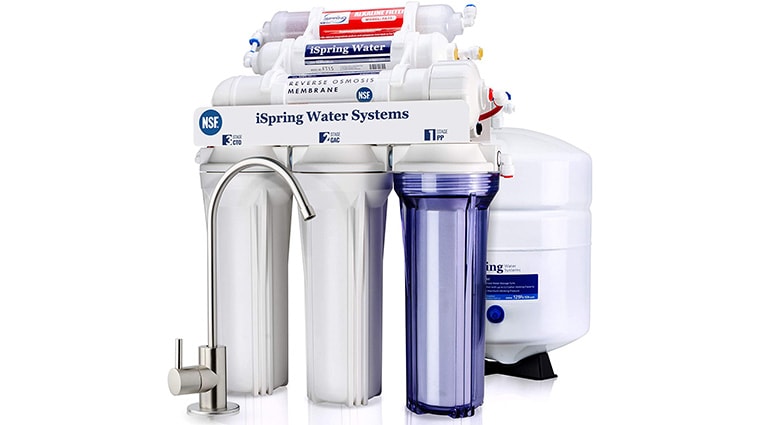
- Six-stage filtration process including alkaline remineralization to restore natural and healthy minerals.
- An ultrasafe reverse osmosis filtration system that can eliminate 99% of more than 1000 contaminants
- Clearly outlined instructions and videos for easy installation.
- Ultrafine reverse osmosis filter for shredding contaminants down to 0.0001 microns
- European style high-spout faucet.
- Reverse Osmosis
- 0.05 GPM
- 75 gallons
- 1,000+
Perhaps the most noteworthy thing about this product is the sheer amount of contaminants it can take out. With several hundred pollutants removable using a complex reverse osmosis system, this product is rivaled by virtually no other competitor in the market.
Unlike many others in the market, the iSpring RCC7AK uses a 6-stage filtration process. The first five, give or take, help to ensure that any contaminants in your water are thoroughly taken care of and removed. Examples of eliminable contaminants include lead (up to 98%), arsenic, asbestos, calcium, sodium, fluoride, chlorine, etc.
In total, this product can take out up to 99% of over 1,000 contaminants. Three of the first five contaminants are extra-long life prefilters. These are ultra-effective in taking out larger contaminants while protecting the reverse osmosis membrane.
After carefully taking out virtually all contaminants in a rigorous cleaning process, the iSpring RCC7AK helps to ensure that your water doesn’t lose too much of its natural minerals. This is achieved through a sixth stage that provides an alkaline remineralization process.
That way, you’ll have water that doesn’t just taste better but is healthier too. This sixth stage is one of the major features that set the iSpring RCC7AK apart from virtually all its competitors in the market and makes it the best reverse osmosis filter.
Beyond these critical features, it comes with an excellently designed and aesthetic European-style kitchen faucet. This dedicated faucet adds to your product lifespan by ensuring that you only make the filter work when you turn it on for drinking and cooking water. Every other time you need water, you could simply turn to other taps in the kitchen.
Finally, installation is as simple as can be. For starters, the product comes with multiple detailed, well-written, and organized instructions. If you learn faster through videos, you can also access instructional videos.
Should you run into any trouble in the installation process, there’s always a technical support team on standby to assist. Quite literally, all the parts you need for installation are readily available within the product package itself.
Finally, the iSpring RCC7AK is duly certified by the NSF/ANSI, lending credence to its excellence.
- Up to 75 gallons total capacity
- Unique alkaline remineralization process
- Up to a thousand removable contaminants
- Easy to install
- Certified by the NSF/ANSI
- Excellent technical support for handling installation and maintenance challenges
- Poor flow rate
- Comparatively short warranty period of one year
Reputation and Customer Feedback
Many customers who bought the product were generally satisfied by its quality. They made particular reference to the great taste and its ability to put out several gallons of water at a time without running out. However, customers also noted the need to follow every installation instruction to the letter to avoid challenges.
Bottom Line
If you’re a household looking for a great under-sink water filter that can serve you and your visitors, this will work great for you. While the flow rate might seem like a challenge, it really shouldn’t be. This is because the dedicated faucet makes it such that you only use it for things like filling a glass cup or a coffee pitcher.
Since you don’t exactly need to fill an entire bucket, speed shouldn’t be much of a problem. Finally, given the negative health impacts of excessive lead consumption, we think this water filter is a great plus to your kitchen.
Aquasana AQ-5200.62 2-Stage
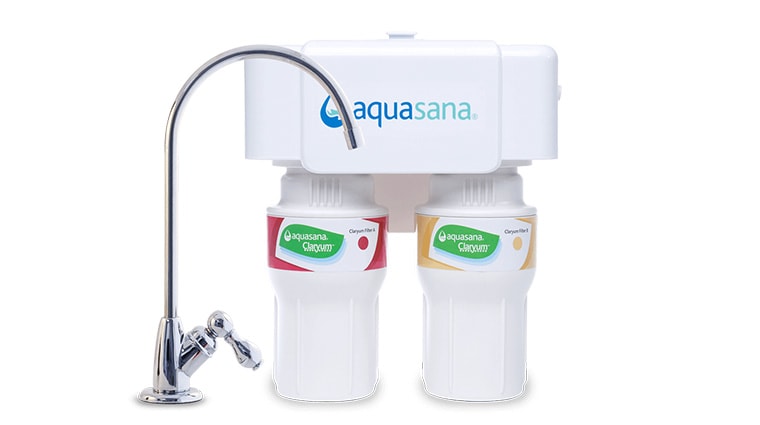
- Clayrum selective filtration system that allows for easy retention of healthy minerals in the water, including calcium, potassium, magnesium, etc
- Stylish and durable faucet made of 100% lead-free metal
- Full NSF certifications to standards 42, 53, 401, +P473
- Lightweight and compact design, aiding installation
- Zero chemical additions during the entire filtration process
- Eco-friendly design with minimal plastic parts
- Conventional
- 0.5 GPM
- 500 gallons
- 77
Virtually every conventional under sink water filter has a faucet. But, the one thing that sets this product apart is that its faucet is made of 100% lead-free metal. This offers a lot of value because metal guarantees a substantial level of durability. Additionally, with metal being the primary build material, you can rest assured that you wouldn’t have to worry about BPA – a chemical often found in plastics – or its resultant effects on your health.
With that being said, it is important to note that this water filter has more to offer than just a fancy faucet with three different stylish finishes. It is also capable of taking out up to 77 different contaminants. This is a significant number, considering that it only has two filtration stages. These 77 contaminants include lead, chlorine, pesticides, and practically every other major source of worry in drinking water that you can think of.
While taking out all these contaminants, the water filter retains the natural minerals. This is possible through its Claryum selective filtration system. This singular trait helps guarantee that while your water is safe to drink, it doesn’t lose its natural taste and become awkward on the tongue.
One of the major things environmentalists would find particularly impressive about this under sink water filter is its eco-friendliness. In every product, the brand uses zero single-use plastic water bottles. This is besides the fact that it is incredibly easy to install with detailed materials, instructions, and guides readily available to assist with the installation process.
Finally, to provide excellent value for your money, the manufacturers included a 90-day guarantee and a 1-year warranty. During these two periods, you’re covered against any significant damages that could pop up while using the product.
- Eco-friendly build
- All-metal durable faucet
- Up to 500 gallons total capacity
- 90-day guarantee
- Selective filtration system that retains natural healthy minerals in filtered water
- A comparatively limited number of removable contaminants
- Comparatively low flow rate/water pressure
Reputation and Customer Feedback
No doubt, the Aquasana AQ-5200.62 2-Stage Under Sink Water Filter System certainly has quite the number of customer reviews across the internet. On Amazon alone, there are over 500 of them. One thing that its users constantly mention is the room for improvement in the flow rate area.
However, beyond that, many people generally enjoyed its filtration work, with the filter being reputed for its excellent tasting water.
Bottom Line
We believe the manufacturers could do better with the flow rate. It would help you to get water when you want it without having to wait too long. However, beyond this, we’re particularly impressed by the 500-gallon capacity. This automatically equals fewer replacements. If you’re looking for something with an NSF/ANSI certification with a big enough capacity to last you several months, this just might be it for you.
Waterdrop 10UB-UF with Faucet
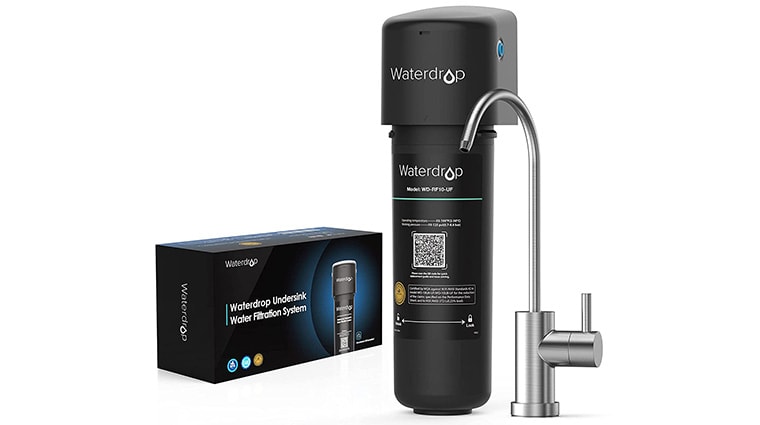
- Full flow rate is 0.75 gallons per minute at 60 psi.
- Unique ultrafiltration technology has an accuracy of 0.01 μm for eliminating chlorine, fluoride, rust, etc.
- Build materials are entirely lead and BPA-free.
- Dedicated brushed stainless steel faucet.
- Easy-to-complete and straightforward installation process.
- Maximum filter capacity of up to 8,000 gallons.
- Conventional
- 0.75 GPM
- 8,000 gallons
- 12+
Many filter producers often forget to optimize it for small kitchen sinks in the process of creating great products. In the end, what you have is an under-sink filter that can’t fit under the sink. This isn’t the case with our Waterdrop 10UB-UF with Faucet. Its small and compact size allows it to perfectly fit under virtually any sink, regardless of the space constraint.
This, however, isn’t the only impressive thing about the Waterdrop 10UB-UF with Faucet. For starters, its peculiar filtration system has a rough accuracy of 0.01 μm. As such, any bacteria larger than this size would be unable to pass through the filters without getting taken out. This guarantees an excellent level of healthiness in your drinking/cooking water.
In addition to that, the build material of this product is stainless steel. It’s completely lead-free, guaranteeing that you won’t be consuming that harmful compound in your drinks. Additionally, because it’s not made of plastic, you can rest assured that you don’t have to worry about BPA either. Finally, with the product being made of steel, you can expect a reasonable level of durability.
At full speed, this filtration system is designed to deliver 0.75GPM through its dedicated water filter faucet. Granted, it certainly isn’t quite as much as the water pressure on regular taps. Still, it’s pretty impressive for a water filtration system and is enough to get you a few cups of water without having to wait too long.
Perhaps one of the most noteworthy things about this NSF/WQA-certified water filtration system is its sheer capacity. It is designed to filter up to 8,000 gallons of water at the very least. Some variations of the model can provide filtration for up to 16,000 gallons, too. Compared to other brands that offer less than a thousand, this filter is miles ahead. If used right, you wouldn’t need a replacement for several months on end.
Finally, this water filter comes with a 30-day guarantee. So, if you feel like you’re not getting the value for your money, despite all the excellent features, you could always try to get that money back.
- Very high filtration capacity
- Impressive accuracy in the filtration process
- Lightweight and compact for installation under tight kitchen sinks
- BPA and lead-free build material
- Easy to install
- Quick flow rate
- Comparatively shorter guarantee period
- Fewer contaminants eliminable than the competition
Reputation and Customer Feedback
One of the things that the Waterdrop 10UB-UF with Faucet is relatively famous for is its sturdy build. Customers often comment on it feeling like something that can be used long-term rather than a cheap assortment of materials that’ll break sooner than later. Others were impressed by how easy the entire installation process was.
Bottom Line
Much like the other internet users, we believe this is an excellent product as well. It’s a great idea if you’re looking to use it in an apartment. The extended filtration capacity makes it such that you don’t have to spend too much money on constant replacements.
Filtrete 3US-MAX-S01
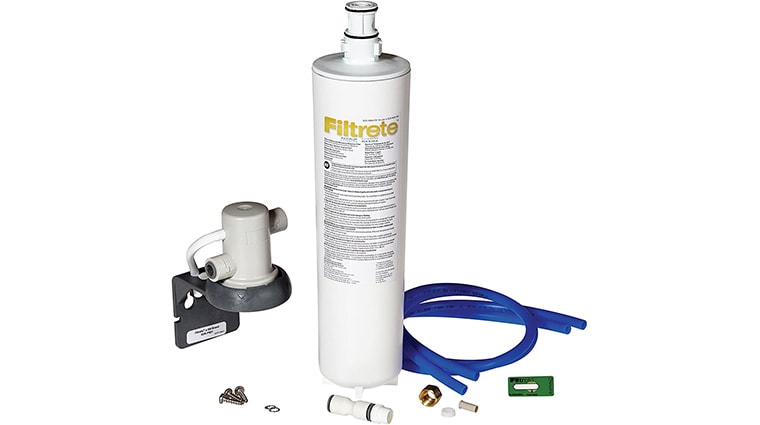
- Quick and seamless installation process.
- Impressive flow rate of up to 1.5 gallons per minute.
- Takes out more than 95% of chlorine, microbial cysts, and lead.
- Each filter can last up to six months before needing replacement.
- The filtration system is certified to NSF 42 standard.
- Uses the existing faucet in the kitchen rather than installing a new one.
- Simple
- 1.5 GPM
- 1500 gallons
- 7+
Virtually every other under sink water filter on our list comes with its faucet. This one takes a different route and instead uses the faucet in the kitchen. This contributes to its unique ability to deliver up to 1.5 gallons per minute, making it the best water filter for your kitchen faucet. With speeds like this, you would never need to worry about waiting several seconds before your cup is filled up.
Beyond that, this filter has a rather impressive filter capacity of more than 1500 gallons. On average, this equals roughly six months of filter use without replacement.
During its use, you can expect it to filter out a solid 99% of lead, 97% of bad chlorine taste and odor, and 99% of microbial cysts. In addition to this, you wouldn’t need to worry about drinking rust, sand, sediments, or soil alongside your water. For clarity, the filtration accuracy level is capped at 0.5 microns.
One more thing that stands out about this product is its quick DIY installation process. In less than 30 minutes, you can have the water filtration system ready for use in your kitchen by following the instructions properly.
Finally, with a length and width of only 3.5 inches and a total weight of 2.2 pounds, this filtration system is compact and can easily fit under your sink with no issues.
- Excellent flow rate of 1.5GPM
- NSF certification
- 30-minute installation process
- Compact and lightweight design
- High filter capacity
- Eliminates tastes and odors easily
- Comparatively low number of contaminants removable
- The lack of a dedicated faucet might reduce filter lifespan
Reputation and Customer Feedback
Many of the product’s users highlighted its ability to deliver great-tasting water without necessarily putting a huge dent in your wallet. Others were impressed by its “A+” lead filtration capabilities. Above all, this water filter is reputed to be one of the fastest in the market.
Bottom Line
We’re certainly impressed by the gallons of water this filtration system can put out per minute. It offers a lot of conveniences. But, we certainly wish it could handle several more contaminants than those it lists as its specialty. Beyond that, however, it does a stellar job of protecting your water from microorganisms, sand, soil, etc. For this reason, among others, it would be an excellent investment for you.
iSpring RCC7AK-UV-7-Stage
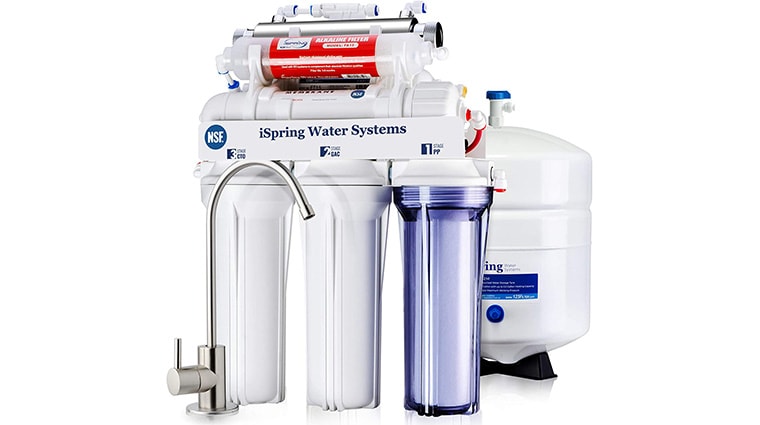
- Advanced reverse osmosis filtration system including an alkaline remineralization process
- Certification against NSF 58/ANSI for TDS reduction
- Seventh filtration stage for treating well water to bring it up to drinkable standard
- Ability to eliminate more than 1,000 different contaminants down to 0.0001 microns
- Multi-layered filter system with transparent 1st stage housing
- Reverse Osmosis
- GPM
- 75 gallons
- 1,000+
If you were to call this water filtration system a “one-man” contaminant killing machine, you would be absolutely right except for the “main” part of that phrase. With its unique and sophisticated 7-stage filtration process, this water filter can seamlessly get rid of pollutants in the toughest waters, including well water.
It accomplishes this through its 11-watt UV stage. But that’s not all there is to the product. Usually, with so many stages of filtration and such rigorous processes, ordinary filters would strip the water of its natural minerals. The result would be a glass of water that’s very clean but tastes quite unnatural and, by implication, unpleasant.
However, to prevent this from happening, the filtration system’s sixth stage is an alkaline remineralization process. It helps to restore the natural minerals in water without all the nasty contaminants it just got rid of. That way, you can have clean, great-tasting water.
Being a reverse osmosis system, this filter relies on a tank to keep water flowing through your faucet. Its tank has a capacity of 75 gallons. Even during your busiest days where everyone’s reaching for a glass of water, you can expect to have a constant supply.
Its high-quality components help you to ensure that you don’t have to deal with incessant replacements all the time. For installation, there’s not much of a challenge there either. iSpring has incredibly detailed instructions penned down to guide you through the entire process. If you’re a visual learner, they have a separate YouTube page that’ll guide you through its step-by-step installation process.
Finally, but very importantly, it comes with an NSF certification.
- Powerful filtration system for dealing with well water
- Eliminate up to 99.9% of 1,000 contaminants
- Easy to install with detailed guides and videos
- Standby customer support
- Alkaline remineralization process to restore natural minerals
- Large tank capacity for extended water supply
- Takes up a lot of space
- Waste to clean water ratio of 2:1
Reputation and Customer Feedback
Several users of this iSpring product found it incredibly helpful for what it was designed to do. Among other things, people love the taste of the water the product generates and the ease of installation. Many of those with negative reviews had challenges with the specific unit they bought, not the model itself.
Bottom Line
If you’re looking for an excellent water filter that can help you deal with very questionable sources of water, this product is a no-brainer. It is incredibly powerful with seven different filtration stages, including one that can help you restore your water’s natural minerals for improved taste. The only major downside is the amount of space it takes. But, considering the value it offers in return, we would say that’s a small price to pay.
How to Install an Under-Sink Water Filter
Installing a water filter under your sink isn’t so hard. As we’ll show here, you can complete it in eight simple steps. They are:
- Turn off the cold water line right underneath your sink. It’s often installed on the right.
- Turn on the faucet to empty it of any cold water that might be left in the line or valve.
- Use a small bucket to get any water spillages under the cold water line. Then, use a wrench to open it up.
- Attach the kit’s adapter to the hose.
- Push the kit’s black tube into the adapter and the filter on separate ends.
- Attach the second adapter to the shut-off valve. Then, push the black tube to the shut-off from the filter.
- Turn on your water.
- Run it for as long as the filter instructions say you should
That’s it! Alternately, you could watch this YouTube video if you prefer a visual learning process.
How to Clean and Replace Filter Cartridges
- Close the valve controlling the system’s flow.
- Open the filter faucet to relieve pressure.
- Use a wrench or your hands to unscrew and remove filter housings.
- Clean cartridges using warm, soapy water and a brush with soft bristles.
- Add ⅔ tablespoon of bleach to one gallon of water to create a sanitizing lotion. Then, add a cup of this to the filter housings.
- Connect the housings back together with the lotion but without their cartridges.
- Open the valve earlier, shut it off and allow it to fill the housings with water.
- Close the faucet when water starts to fill it up.
- Leave the housings and sumps for 30 minutes to contact water and bleach.
- Remove the filter housings again and place cartridges within.
- Run water through them for five minutes to flush and reactivate filters.
Under Sink Water Filters vs. Countertop Water Filters
Similarities Between the Two
These two products don’t have a lot in common. Of course, they’re both commonly used across multiple households in the country. They’re also two different products that essentially help you to filter contaminants out of your water. But, beyond that, there’s not much else they have in common. Differences, however, are a’plenty.
Differences Between the Two
● Under-sink filters are installed under your sink, while countertop filters take up space on your counter, not beneath it.
● Under-sink filters are much less portable and need to be in one place. At the same time, you can easily carry around countertop filters.
● Undersink water filters have relatively more in-depth filtration processes owing to the multiple stages they’re built with. Countertops, on the other hand, might struggle with taking out some contaminants.
● Almost every time you buy an under sink water filter, you’ll need to go through an installation process of some sort. In some of those processes, you’ll also need a dedicated filter faucet. Thankfully, it almost always comes with the water filter itself. But, this isn’t the case with countertop water filters. With these products, depending on the specific type you purchase, you might only need to plug it in and fill it with water.
Under-Sink Water Filters vs. Water Pitcher Filters
Similarities Between the Two
Much like under-sink filters vs. countertops, these, too, do not have a lot in common. Multiple people in varying capacities often use them, and they have roughly the same functions. But, other than that, they don’t often see eye to eye.
Differences Between the Two
● Under-sink water filters often have a very intricate filtration system. This enables them to remove up to 0.0001 microns of more than 1,000 contaminants from water. Some of them even come with UV mechanisms to eliminate contaminants in well water. Water filter pitchers, however, are designed for “softer” use. As such, they might not be able to remove that many contaminants from water.
● A water filter pitcher can easily sit on any surface in your home and get the job done from there. An under-sink water filter, however, needs to be explicitly installed under your sink. Otherwise, you might have trouble using it.
● Under sink water filter pitchers usually require a faucet to dispense water after filtration. Filter pitchers work like regular pitchers and simply let the water out through an opening at the top.
● Under-sink water filters are fixed. Pitchers are more portable and mobile.
Tips and Cautions
Here are a few useful expert tips and cautions you should remember as you set out on your under-sink water filter journey:
Expert Tips
- Micron rating: The smaller the micron rating, the fewer contaminants can pass through it.
- Misleading claims: Don’t believe a company’s claims about having NSF/ANSI’s level of testing unless they’ve been certified by NSF/ANSI themselves.
- Wide availability: You’ll need to change your filters often. Make sure that they’re widely available, so you’re not stuck with a system that has no filter.
Cautions
- Hard water: A water filter will do you much good if you have hard water. It will counteract the effects of magnesium or calcium in your water. Especially with the potential health challenges of hard water, it’s best to know if you have hard water and start solving it using a water filter now.
To find out if you have hard water, simply pour some water into a bottle. Then, put some liquid soap in. Shake thoroughly and check for foam/lather. If there’s little to none, you might have hard water. - Cost competitiveness: You shouldn’t be getting something at a certain price when you can obtain more value for less or just a bit more.
- Hardware quality: Water filters and faucets made of stainless steel are often more durable than plastic, among other materials.
Conclusion
It took several hours of research and testing multiple products in a nearly oversaturated market. But, it’s safe to say that the iSpring RCC7AK 6-Stage is hands down the best under-sink water filter system in the market.
Its filtration system is a complex set of processes that can eliminate 99% of over a thousand contaminants in water, including the most dangerous ones like lead. Alongside that, its alkaline remineralization process helps ensure that your water is pure but still tastes natural. Finally, it makes installation as simple as can be with detailed written guides and videos to help.
FAQs Related to Under-Sink Water Filters
What is the best under sink water filtration system?
The best under-sink water filtration system is the iSpring RCC7AK 6-Stage. This filtration system has a unique 6-stage filtration process—the first five help to take out 99% of over 1000 contaminants. The final one helps to restore natural water minerals for great-tasting water.
How long do under-sink water filter systems last?
Under-sink water filter systems last for varying amounts of time, depending on their usage level, the water quality they filter, and the maximum capacity. On average, however, many filters need to be replaced once every six months.
Which water filter removes the most contaminants?
The water filter that removes the most contaminants is the iSpring RCC7AK 6-Stage. It can easily take out 99% of 1000 pollutants from water. This includes lead, fluoride, chlorine, arsenic, etc.
How often should I change my under-sink filter cartridges?
You should change your under-sink filter cartridges every four to six months on average. However, you might need to change it more or less frequently, depending on how contaminated your water supply is.
Do under-sink water filters waste water?
Not all under-sink water filters wastewater. It’s only reverse osmosis filters that have to discard wastewater consisting of contaminants removed from your drinking water. This can be mitigated by using a water filter with a low waste to filtered water ratio of at most 3:1 or, even better, 2:1.


